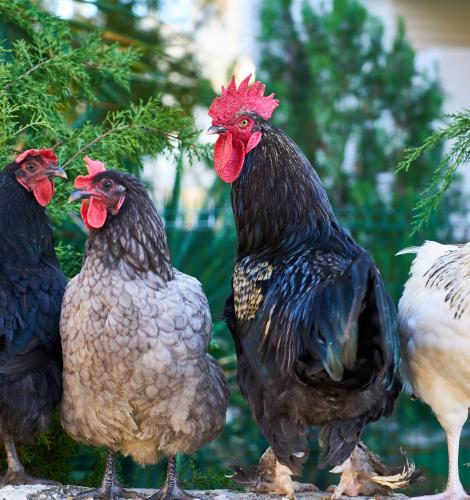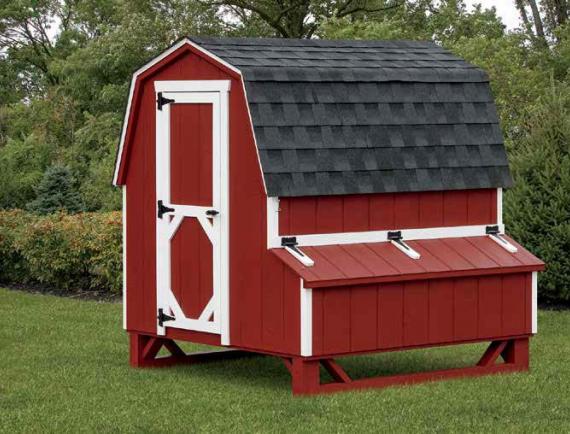
Aside from deciding between breeds, like Silkie, Brahma, and Wyandotte, chicken owners also need to consider housing. For example, whether a chicken coop should be a permanent structure on the property or a mobile tractor-style home.
Built on wheels or ski-like skids, a mobile coop or “tractor,” is exposed to the ground on the bottom allowing chickens to forage and fertilize the ground underneath the coop. A tractor is movable around your yard, too, preventing one area of grass from overuse and eventual browning.
A tractor coop, however, is not a safe overnight haven. Many predators can easily lift or dig under the tractor and attack. If you have space, a permanent chicken coop provides many benefits for both you and the birds.
Permanent Chicken Coop Styles
There are generally two types of chicken coops; walk-in sheds and lift-up roofs. You may also like the idea of an all-in-one coop, which combines them with a chicken run.
A walk-in chicken coop is large enough for you to stand at full height and complete the chores required for care. If you have the space to construct a shed style coop, the walk-in will make chores and medical care of your hens more accessible.
Settling on this type of habitat requires careful site selection, access to water, electricity, and an easy walk from your house. In the long run, though, a walk-in coop makes cleaning and maintaining a healthy space for your hens much simpler.
A lift-up roof gives you access to the contents of your chicken coop from the top of the structure. From the exterior of the coop, you must be able to reach the eggs, restock bedding in the nests, and sweep poop and debris off the floor.
Regardless of whether you attach it to the coop or build it as a separate structure, your chickens need a safe, fenced in space to exercise, explore, and enjoy the outdoor air. A chicken run is an open-air space providing 3-6 square feet for each bird.
Also, it must be at least 4 feet high or can be covered with wire fencing for additional protection. A chicken run can be incorporated into the coop design or surround the entire coop structure if you have enough land.
A Coop's Basic Functions
Whether you settle on a walk-in or lift roof, all chicken coops should provide the following components for the health and safety of your hens.
Shelter
Safety from rain, wind, and cold ensure the coop's interior temperature is always between 40 and 85 degrees Fahrenheit.
Protection
Security from predators, which include raccoons, opossums, foxes, coyotes, skunks, weasels, owls, and more.
Space
Hens need approximately 2-4 square feet per bird inside the coop depending on their size. Consult with an experienced breeder to learn how much space your particular hens will need.
Light
Having enough light is crucial. Even on an overcast day, your chickens need 14 hours of sunlight.
Ventilation
Mold, mildew, and a build-up of ammonia smell from urine are prone to a coop environment. Fresh circulating air will help keep the structure and the hens healthy.
Hygiene
You should be able to easily access all areas of the coop in order to remove litter, sweep the floors, and swap out bedding.
4 Essential Interior Features
Just like any tiny home, there are ways to optimize your chicken coop like adding automatic doors, feeders, and waterers. Below are some basics required for every chicken habitat.
Roost
A roost is a pole placed higher than the nest, which hens use to sleep. When selecting materials, if the coop gets cold in the winter, a wood roost prevents additional chill on your birds’ feet. The roost pole should be flat on the top and bottom for maximum comfort.
Nest Boxes
Nest boxes provide a safe, private space to lay eggs. Your coop needs to have at least two nests for a flock of 3-4 chickens. Some people build one nest for each bird, but hens will share nest boxes, so this isn't necessary. Nests need to be 3-4 feet off the floor, measuring 12” square, open to the front with a lip to keep the bedding from falling out.
Windows
As mentioned above, your coop needs light and ventilation. Windows that open allow for both but when you select one, be certain it is secure, contains a hefty screen or chicken wire, and cannot be opened by predators.
Ventilation
Ventilation is here twice for a reason. The importance of clean air cannot be emphasized enough - chickens absolutely need fresh air to prevent respiratory illness. Install a vent open to the outside to create a healthy space. As with windows, the vent you use should be secured against predators.
During your hunt for chicken coops, keep these recommendations in mind! And no matter which chicken coop you choose, make sure you have the right features for your chickens’ safety. If you have any questions, or need any help in your chicken coop search, give us a call or contact us today.